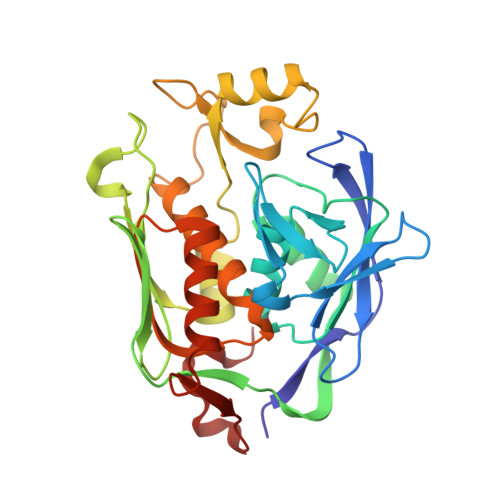Structural Basis of the Promiscuous Inhibitor Susceptibility of Escherichia coli LpxC.
Lee, C.J., Liang, X., Gopalaswamy, R., Najeeb, J., Ark, E.D., Toone, E.J., Zhou, P.(2014) ACS Chem Biol 9: 237-246
- PubMed: 24117400
- DOI: https://doi.org/10.1021/cb400067g
- Primary Citation of Related Structures:
4IS9, 4ISA, 4MQY - PubMed Abstract:
The LpxC enzyme in the lipid A biosynthetic pathway is one of the most promising and clinically unexploited antibiotic targets for treatment of multidrug-resistant Gram-negative infections. Progress in medicinal chemistry has led to the discovery of potent LpxC inhibitors with a variety of chemical scaffolds and distinct antibiotic profiles. The vast majority of these compounds, including the nanomolar inhibitors L-161,240 and BB-78485, are highly effective in suppressing the activity of Escherichia coli LpxC (EcLpxC) but not divergent orthologs such as Pseudomonas aeruginosa LpxC (PaLpxC) in vitro. The molecular basis for such promiscuous inhibition of EcLpxC has remained poorly understood. Here, we report the crystal structure of EcLpxC bound to L-161,240, providing the first molecular insight into L-161,240 inhibition. Additionally, structural analysis of the EcLpxC/L-161,240 complex together with the EcLpxC/BB-78485 complex reveals an unexpected backbone flipping of the Insert I βa-βb loop in EcLpxC in comparison with previously reported crystal structures of EcLpxC complexes with l-threonyl-hydroxamate-based broad-spectrum inhibitors. Such a conformational switch, which has only been observed in EcLpxC but not in divergent orthologs such as PaLpxC, results in expansion of the active site of EcLpxC, enabling it to accommodate LpxC inhibitors with a variety of head groups, including compounds containing single (R- or S-enantiomers) or double substitutions at the neighboring Cα atom of the hydroxamate warhead group. These results highlight the importance of understanding inherent conformational plasticity of target proteins in lead optimization.
Organizational Affiliation:
Department of Biochemistry, Duke University Medical Center , Durham, North Carolina 27710, United States.


















